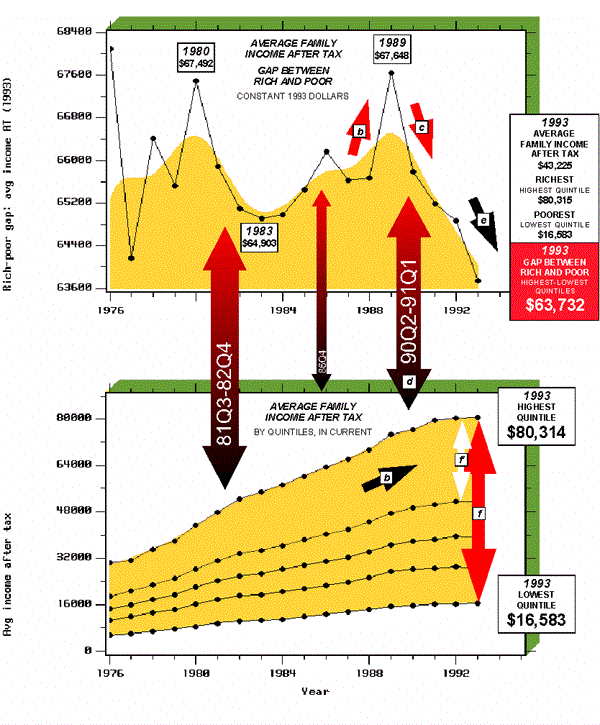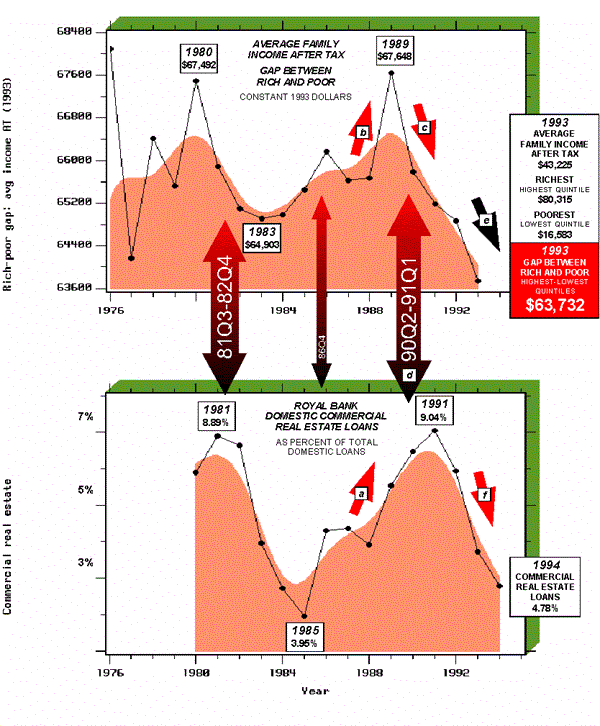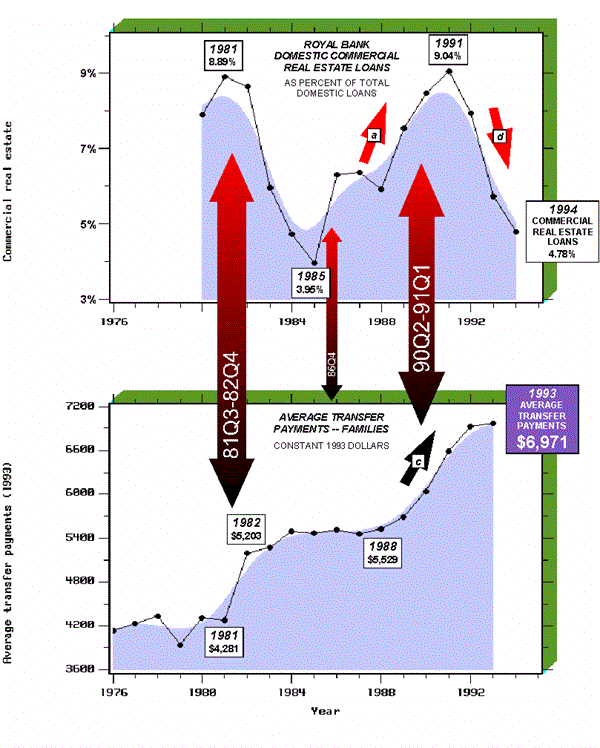|
APPENDIX G
The Business Cycle --
The Rich-Poor Income Gap
This Appendix seeks answers
to two sets of questions:
- Did
the rich "exploit" the poor? Is there any evidence corroborating a net
transfer of wealth to the richest families, from poorer families? More specifically,
did the rich-poor income gap (in constant dollars) increase during overinvestment
periods?
- What
was the government's response to the deterioration in the income gap? Did the average
transfer payments per family (in constant dollars) increase during recessionary
periods?
|
|
The
Business Cycle1
The
Rich-Poor Income Gap |

OVERINVESTMENTS
DID THE RICH
"EXPLOIT" THE POOR?
The income gap between the rich and the poor swelled (arrow a) before each recession (arrow d). Recently, however, the gap shrunk (arrow e).
Should the
rich worry? The gaps between the
rich and the middle class (2nd quintile) and between the rich and the lower middle class
(middle quintile) have widened after 1982. Both Liberals and Tories have pushed
"conservative" or "right-wing" agendas. But, "insecurity,"
"anger," "distrust," feelings of "betrayal," and
"separation anxiety" continue to bedevil Canada, the United States, and other
countries. |
|
Chart G-1
The Rich-Poor
Income GapThe
average after-tax income gap between the highest and lowest quintiles (richest and poorest
families) swelled from $24,802 in 1976 to $63,732 in 1993 (arrow f). Note that the after-tax income gap
between the highest two quintiles (richest and next richest families) swelled from $11,285
in 1976 to $28,794 in 1993 (arrow f').
Sources: Statistics
Canada, Income After Tax, Distributions by Size in Canada 1993, Catalogue 13-210,
June 1995 (distribution of family income after tax, by size, in constant 1993 dollars);
and Statistics Canada, Canadian Economic Observer, Historical Statistical Supplement,
1994/95, Catalogue 11-210, July 1995 (CPI deflator).
[Copyright © 1998 by
MACROKNOW INC. All rights reserved.]
|
|
The
Business Cycle2
Did
Overinvestments in Commercial Real Estate Benefit the Rich? |

OVERINVESTMENTS
DID THE RICH
"EXPLOIT" THE POOR?
Expansions in loans to the commercial real estate sector (arrow a) were followed by speculative overinvestments
and recessions (arrow d). Curiously, the income gap between the rich
and the poor swelled (arrow b) just before each recession. These increases
provide powerful evidence of a net transfer of wealth to the richest families, from poorer
families. Note that the excesses backfired -- the income gap shrunk in 1993 (arrow e). |
|
Chart G-2
Did
Overinvestments in Commercial Real Estate Benefit the Rich? Links Between the Real Average
Rich-Poor Family Income Gap and Commercial Real Estate LoansSources: Royal Bank annual reports
(loans by industry, as at September 30); Statistics Canada, Income After Tax,
Distributions by Size in Canada 1993, Catalogue 13-210, June 1995 (distribution of
family income after tax, by size, in constant 1993 dollars); and Statistics Canada, Canadian
Economic Observer, Historical Statistical Supplement, 1994/95, Catalogue 11-210, July
1995 (CPI deflator).
[Copyright © 1998 by
MACROKNOW INC. All rights reserved.]
|
|
The
Business Cycle3
Transfer
Payments to Families |

| OVERINVESTMENTS
COUNTER-CYCLICAL POLICIES -- THE LINK
BETWEEN OVERINVESTMENTS, RECESSIONS, AND TRANSFER PAYMENTS.
The gap between the after-tax incomes of families in the highest (richest) and lowest
(poorest) quintiles increased by about $49,941 (362%) -- from $13,791 in 1971 to $63,732
in 1993! To remedy the deterioration in the rich-poor income gap, the government was
forced to increase transfer payments to families. The average transfer payments per family
in 1993 was $6,971 (up $4,397 from 1971, in constant 1993 dollars). Most of the increases
in transfer payments occurred during or immediately after recessions. |
|
Chart G-3
The Government's
Response to the Devastations of the Overinvestment Cycle: More Transfer Payments to
FamiliesOverinvestments
in the commercial real estate sector (arrow a) induced recessions (arrow b) -- with devastating social and
economic consequences for many. Recessions forced the government to increase transfer
payments (arrow c); these increased governmental deficits.
Sources:
Royal Bank annual reports (loans by industry, as at September 30); and Statistics Canada, Income
After Tax, Distributions by Size in Canada 1993, Catalogue 13-210, June 1995 (average
transfer payments, families, in constant 1993 dollars).
[Copyright © 1998 by
MACROKNOW INC. All rights reserved.]
|
|

|


